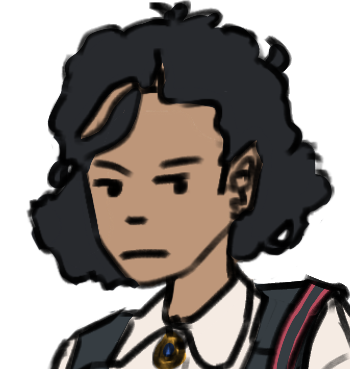NEW Story: Cocktail
A Foreigner’s Guide to Female Traditional Dress in Vekllei
Saturday, Jan 11, 2020

This article is not part of Vekllei canon. It may be old, obsolete or just a bit of fun.
Tzipora, illustrated here, is happy because her traditional dress makes her feel stylish and her cape is soft and warm.
Vekllei is an ancient culture with many inherited and vestigial artefacts. Nowhere is this more apparent than in her national dress, particularly that for women, where old and new collide as they do all across Vekllei. Pre-war, post-war and future are present here. Let’s run through some of the elements, which can be found throughout her society.
- Fountain hairpieces. These are the centrepieces of Vekllei ceremonial hairstyles, and are aided by sticks traditionally or more commonly gels today. These are only for women, and are arranged at the top of the head. Hats are not worn with traditional dress, and the Fountain hairpieces date back to the 12th century, in initial Danish settlement.
- Temple hairpieces. These hairpieces are fastened symmetrically at the side of the head, and accompany the fountain. Traditionally an exclusively male style, it was incorporated into women’s culture in postwar liberalisation.
- Uroastopet (birth flower) hairpieces. Flowers are central component of Vekllei animistic iconography, and their employ with people is analogous to Zodiac or astrological traditions. A birth flower is usually attached as a hairpiece in ceremony to distinguish the girl against the stars, acknowledging the chance in her birth not dependent on blood or heritage.
- Floral collar pins. These are recent items that first appeared in the last half-century, in response to the urbanisation of Vekllei life. Where traditionally flowers would be attached to the collar, here they are replaced by enamel and metal pins that are also worn with business and school shirts.
- Regional Flower Plate. This unusual item displays a special floral arrangement, called a ro poisnesn (flower-tundra blood arrangement) which can be genuine or artificial. It displays a curated collection of flowers from the girl’s village or region, usually selected from a local flower-tundra.
- Camisole Pinafore. These pinafores first appeared as detachable suspenders in the 19th century and have become an indispensable component of styles and uniforms since. Like most elements of Vekllei ceremonial dress, its origins are in agriculture.
- Refined Women’s Tie. A woman’s tie is carefully folded to respect the integrity of its sacred source; the shape and cascading petals of the Oa flower, which is the national Vekllei symbol. Men have a similar item that fastens to the neck of a tie.
- School/workplace armband. Armbands are universal in Vekllei. Instead of a symptom of authoritarian workplace culture, they are instead seen as markers in the country of public face. They are found in most professions and schools and have even seen ironic popularity in progressive fashion scenes.
- Dien agricultural shirt. These loose, baggy cotton shirts rolled at the elbow are a uniquely Vekllei style of dress, and appeared just prior to the time of the Camisole pinafore. Originally a male item, it is mostly worn by women today in professional and casual settings alike.
- Uroaten floral belt. These belts are mural testaments to the lineage of a girl, usually displaying the birth flowers of her female relatives.
- Bell Sash. The bell sash jingles as she moves and it sounds nice. The girls pick the bells themselves, and different sounds have different meanings.
- Oanan lace apron. These aprons are rarely worn, because they are extremely delicate, but they are precious cultural items often handed down through generations. Girls are often married in them. In postwar life, they are iconic for how the woman has been liberated from work — where even her aprons are stripped of utility and transformed into beautiful decorations.
- Honey half-cape. Vekllei is very cold, and half-capes or full-capes are often worn. You’ll find them in school uniforms and throughout professional workplaces in the country. They are interchangeable with other long coats, but are beloved for their versatility, warmth and softness.
- Gi quarter-pleat. These are very sacred items, and are designed specifically for the girl at her menarche. They usually incorporate their birth flower, birth festival and other iconography into their patterns. Girls wear them to school. Boys also have gi, but they are much smaller and not nearly as intricate.
- Glory Sash. A glory sash is affixed to the uroaten and proclaims the beauty of the girl’s family through religious iconography and runes, called upotenne.
- Thousand-pleat skirt. Traditionally skirts without pleats are worn, but postwar manufacturing has gifted young women with many types of skirt and pleat less varieties have been largely substituted for decorated or “thousand-pleat” versions.
- Sun petticoat. These are petticoats that hang below the hem, and often accompany the oanan lace apron as a set. Like the oanan, these are very delicate and are usually only worn on special occasions. Pure white, they dirty easily below the hem and are mostly decorative, although they do have utility in supporting the weight of the girl’s skirt with pleat and sash attached.
- Mido socks. A longer cotton sock is folded three times to make a cuff, which offers versatility in a climate that changes without warning. At the hem’s current fashion, a mido sock can instantly become a stocking of sorts, depending on the make and taste of the girl. They are worn throughout the country, including in business environments.
- Misc. felt/leather shoes. There are several types of traditional Vekllei shoe, from old boots and sandals to modern makes of foreign design, like penny loafers. The choice is the girl’s, for it is by far the most impermanent style of the outfit.
Traditional dress is worn on holidays, to church, in festivals and in ceremony at school and work. To many Vekllei people, it epitomises womanhood.
